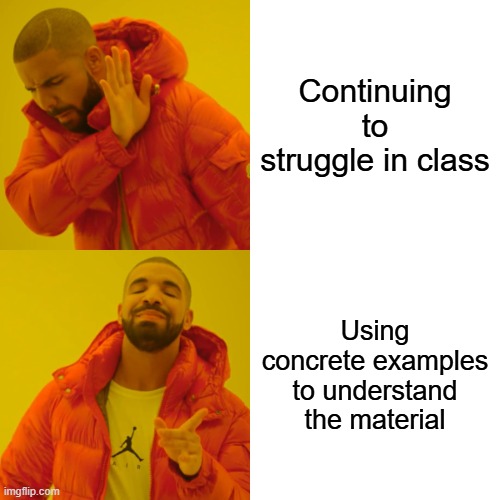By Bekah Gleason

What are Concrete Examples, and How do they Work?
Have you ever wondered why some teachers or professors will use real-world situations or concepts to explain certain topics? You could say that it’s because they aren’t great at explaining concepts in class, and had no better way to drive home a point. But in reality, they are using concrete examples to amplify your learning experience, make the lesson memorable, and fill in the gap between hard-to-grasp concepts and reality. So, what are concrete examples, really? Concrete examples are specific, real-life examples (or tasks) that help to illustrate an idea or concept (2). Concrete examples are an extremely powerful tool that will help turn abstract ideas into tangible concepts that are easier for students (or anyone) to grasp. There are multiple advantages to using concrete examples to supplement your studying and aid the learning process (5).
Some advantages include (5):
- 1) Good concrete examples are able to effectively convey information- which increases your comprehension
- 2) They provide students with information that is easier to remember
- 3) Visual or hands on concrete examples take advantage of the dual coding theory (information is processed and stored both visually and verbally)
There have been multiple studies conducted to show the effectiveness of using concrete examples. A large amount of the evidence for the effectiveness of using concrete examples is a study by Rawson et. al. (2015) (4). In this study, it was found that using concrete examples significantly improved the learning of abstract concepts. In a similar study, run by Basnakova et. al. (2021) the same results were concluded, although there was more variation in the results (1).
There are pros and cons to using concrete examples for studying, as there are for almost all study tools. What works for someone else (or even for a specific class) may not work the best for you (or that class), so it’s important to find a blend of what works best. Take the two studies that I previously mentioned into account. The Rawson study was conducted among psychology students- and the use of concrete examples helped them process information immensely (4). However, the Basnakova study (which covered scientific reasoning as the concept) had less consistent results (1). Concrete examples don’t work for every subject or topic, but for the topics that they are able to work alongside, concrete examples will dramatically increase your comprehension and understanding of the concepts.

How to use Concrete Examples
The best way to show you how concrete concepts work (and how to use them), is by using them. Take the concept of ‘deindividualization’ for instance (3). Deindividualization is a social psychology concept that explains the loss of a sense of self and identity when in a group- you become so immersed in the group that you lose certain aspects of yourself, exhibit new behaviors, and lose personal accountability. A concrete example of deindividualization could be drinking much more than you typically would at a party. You feel more inclined to drink due to the social setting, and there is a level of anonymity due to the amount of people at the party.
Using concrete examples is as simple as taking one concept, and tying it to real-life scenarios or other concepts to help you better understand the main concept (which will also help to improve your recall and retrieval when testing or doing homework- therefore improving your grade!). You can use concrete examples for almost any subject, although they must be used alongside other study methods- concrete examples are simply a supplement (and a great one). Concrete examples can take multiple forms, but all are done by tying an unknown concept to something you can easily grasp (like the example I gave you). Some forms that concrete examples take are relating the information/concepts to things happening/that have happened in the world (pop culture, historical events, etc.), relating the information to personal events (the trickiest and least reliable of the choices), and hands-on learning experiences and lab work.
Conclusion
The next time a professor uses real-world examples or other examples to better explain a topic, appreciate it! They are using concrete examples to help you! Like I’ve already covered, concrete examples enhance your ability to learn new information, increase the ability to store the new information, and increase your ability to retrieve and recall the stored information. All-in-all concrete examples are a great study tool to employ to ensure success in school. Again, concrete examples cannot be used on their own- in order to use them successfully and use them to their full potential, they have to be used in tandem with other study tools. Create a study regimen out of a blend of study tools that work best for you- and make sure that you incorporate concrete examples!

References
(1)Bašnáková, J., Čavojová, V., & Šrol, J. (2021). Does Concrete Content Help People to Reason Scientifically?: Adaptation of Scientific Reasoning Scale. Science & Education, 30(4), 809–826. https://doi.org/10.1007/s11191-021-00207-0
(2)Instructional Delivery | Concrete Examples. (2018). Dot.gov. https://www.nhi.fhwa.dot.gov/LearnersFirst/concrete-examples.htm
(3)Micallef, A., & Newton, P. M. (2022). The Use of Concrete Examples Enhances the Learning of Abstract Concepts; A Replication Study. Teaching of Psychology, 51(1), 009862832110580. https://doi.org/10.1177/00986283211058069
(4)Rawson, K. A., Thomas, R. C., & Jacoby, L. L. (2014). The Power of Examples: Illustrative Examples Enhance Conceptual Learning of Declarative Concepts. Educational Psychology Review, 27(3), 483–504. https://doi.org/10.1007/s10648-014-9273-3
(5)Weinstein, Y., Madan, C. R., & Sumeracki, M. A. (2018). Teaching the science of learning. Cognitive Research: Principles and Implications, 3(1), 1–17. Springer Open. https://doi.org/10.1186/s41235-017-0087-y